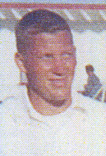 Leo Payne was a leading drag racer and top-speed record racer from the 1950s through the 1970s. He was a drag racing champion and set numerous records on his highly modified Harley-Davidson Sportsters. His custom-built machine, dubbed "Turnip Eater," was also the first non-streamliner to go over 200 mph at the Bonneville Salt Flats in 1969. Payne was a master at building special carburetors to run a nitromethane and gas combination. Payne’s designs helped S&S Cycle launch a successful line of racing carburetors.
Leo Payne was a leading drag racer and top-speed record racer from the 1950s through the 1970s. He was a drag racing champion and set numerous records on his highly modified Harley-Davidson Sportsters. His custom-built machine, dubbed "Turnip Eater," was also the first non-streamliner to go over 200 mph at the Bonneville Salt Flats in 1969. Payne was a master at building special carburetors to run a nitromethane and gas combination. Payne’s designs helped S&S Cycle launch a successful line of racing carburetors.
Payne was born in St. Louis on March 10, 1931. He was raised in Flora, Illinois, and attended Boys Town in the 1940s. He bought his first motorcycle when he was 19, but the Korean War cut short his new hobby. After the war, Payne moved to Cedar Rapids, Iowa, and went to work part-time for a Harley-Davidson dealership. There he began to modify his bikes and he quickly earned a reputation as having one of the fastest Sportsters in the Midwest.
Payne began racing and winning local drag racing events, which helped spread his reputation. He was one of the first motorcycle drag racers to use the burnout method of warming his rear tire. These tire-smoke-filled pre-race rituals often psyched-out his opponents.
Payne became known for his lightning-quick reaction times. He claimed the quick reactions came from his job at Quaker Oats, where he would sharpen his sense of timing by pitting his reactions against the start-stop lights of box-filling machines.
As a mechanic, Payne was especially skillful at modifying carburetors for drag racing. He helped support his racing by rebuilding carburetors for hundreds of Sportster owners. This attracted the attention of popular aftermarket performance company S&S Cycle. George Smith, of S&S, contacted Payne about helping his company build a performance carburetor. The Payne-designed S&S carb became a big seller for the company and further cemented Payne’s status as a leading builder.
Payne had a habit of naming his racing bikes – Quarter Horse, Drag Sport and the most popular of them all, the Turnip Eater. The name of the bike, which started life as a 1957 Harley-Davidson Sportster, was said to be a reference to the American-made machine eating up British-made brands on the drag strip. His bikes had the engraving of "In God We Trust" on the clutch covers. No one knew for sure if it was a show of religious faith or a humorous statement on what it was like to race one his intimidating fuel-burning racers.
Popular television personality and fellow Hall of Famer Dave Despain was an early fan of Payne’s.
"Some of my earliest racing memories are of Leo," Despain recalled. "When I was in high school, we went every Saturday night to the drag strip in Kahoka, Missouri, which always ran a bike class. Leo was the big gun, riding his famous 'Turnip Eater.' When Leo went 200 at Bonneville, Harley made a poster of the accomplishment. We had that framed and hanging in the living room of the flophouse where I lived with a bunch of other deadbeat Sportster riders."
Payne won numerous titles and set countless records in the often informally sanctioned motorcycle drag races of the 1960s. Payne was noted for his consistency on the drag strip where his runs rarely varied by more than a few hundredths of a second. He won with single-engine bikes during an era when dual- and even triple-engine dragsters came into vogue. One of Payne’s secrets was shaving a great deal of weight off his Sportster-based dragsters. He eliminated all unneeded parts and removed enough metal to get the normally heavy Harleys down to just over 300 pounds.
Payne was featured in a number of motorcycle magazines in the late 1960s and early 1970s. One feature, written by Cook Neilson for Cycle Magazine in 1969, gave an account of Payne’s successful run at the Bonneville Salt Flats that year. It was in 1969 that Payne’s Turnip Eater set several records, including hitting a top speed of over 201 mph, en route to an average of 196.512. His trap speed of 201 made Payne the first rider in history to push a non-streamliner to over 200 mph. His bike was towed up to 70 mph before he fired it up to begin the run. To save weight he used a single-speed transmission, which meant he had to slip the clutch up to about 110 mph. That year he broke the existing class record by a margin of 43 mph.
Payne continued to be involved in racing through the 1980s. He helped many young riders get their start in drag racing. Payne died from cancer on September 18, 1991. He will always be remembered for squeezing more horsepower and speed out of Harley-Davidson Sportsters than anyone ever thought possible.